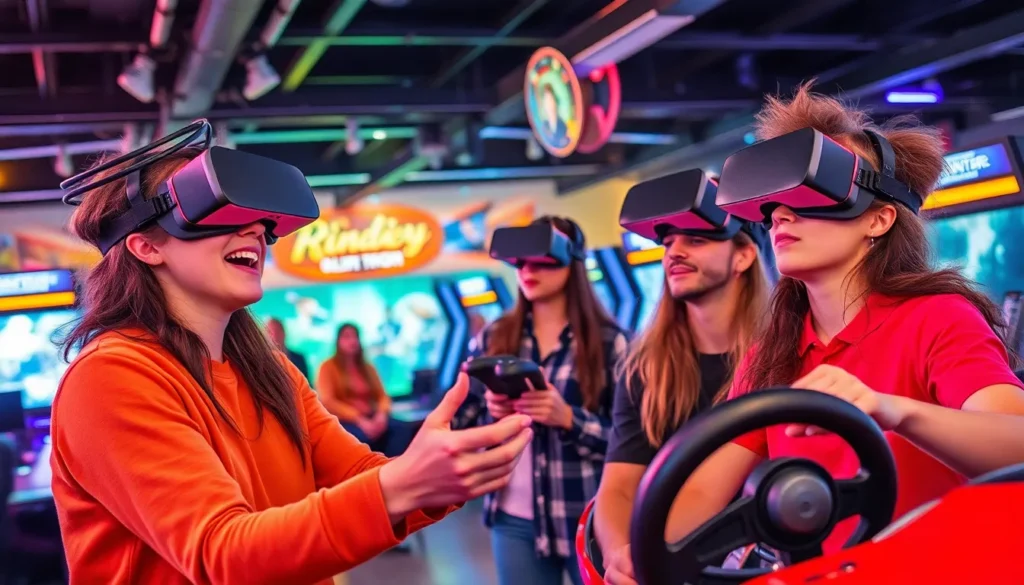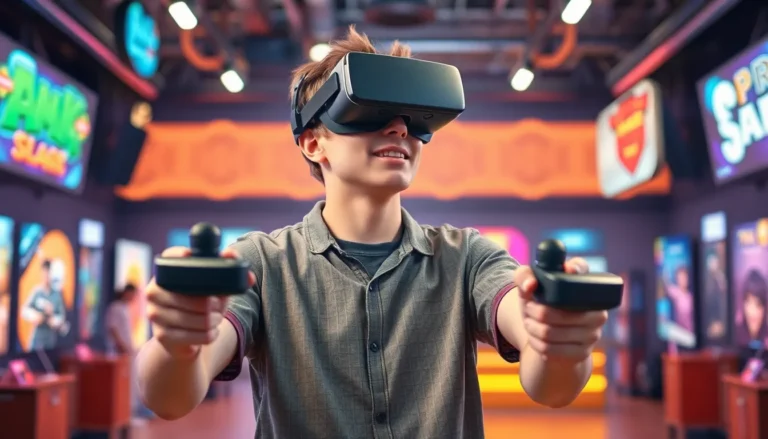Table of Contents
ToggleImagine stepping into a world where you can battle dragons, race through futuristic cities, or even dance with virtual celebrities—all without leaving your city block. Welcome to the VR arcade, the playground of the digital age where reality takes a backseat and imagination revs up the engine.
Overview of VR Arcades
VR arcades offer a unique entertainment experience combining advanced technology with social interaction. Customers wear headsets, enabling them to enter diverse virtual environments, from thrilling adventures to relaxing landscapes. Engaging with captivating games and simulations creates memorable experiences for all ages.
These facilities typically feature several VR stations, each equipped with high-end hardware and a variety of games. Popular experiences include escape rooms, racing simulations, and multiplayer battles, allowing participants to choose activities that match their interests. Gamers and non-gamers both benefit from the chance to explore new realms together.
Most VR arcades employ trained staff to assist users and maintain equipment. Personnel ensure that VR headsets are functioning properly and guide customers through the setup process. With enhanced safety protocols, arcades prioritize cleanliness to provide a comfortable environment.
In terms of accessibility, VR arcades cater to diverse audiences. Many locations offer tiered pricing options, making experiences affordable for groups or individuals. Arcades often host events, tournaments, and birthday parties, fostering community engagement and creating memorable celebrations.
Overall, VR arcades capitalize on advancements in technology and changing entertainment preferences. By blending social experiences with immersive gaming, these venues satisfy the growing demand for interactive and engaging leisure activities.
The Technology Behind VR Arcades

The technology behind VR arcades combines advanced hardware and immersive software experiences. These elements work together to create engaging environments for users.
Hardware Components
VR arcades rely on high-end hardware to deliver exceptional experiences. Head-mounted displays provide immersive visuals, while motion controllers enable users to interact seamlessly with virtual worlds. Powerful gaming PCs handle complex graphics and simulations, ensuring a smooth experience. Additional accessories like haptic feedback vests enhance sensory engagement by delivering tactile sensations. VR stations are designed for comfort, accommodating various player sizes and preferences. Designers focus on user-friendly setups, ensuring that accessibility remains a priority.
Software Experiences
A diverse range of software experiences captivates users in VR arcades. Flight simulators transport players into the cockpit of aircraft, allowing them to navigate realistic skies. Multiplayer environments promote social interaction, enabling friends to team up or compete against each other in various games. Escape room scenarios challenge groups to solve puzzles under time constraints, enhancing problem-solving skills. Relaxing landscapes invite users to unwind, showcasing beautiful virtual environments. Game developers continue to innovate, frequently updating libraries to keep experiences fresh and engaging, meeting different interests and age groups.
Popular VR Arcade Games
VR arcades feature a diverse range of popular games that enhance the immersive experience. These games cater to various interests, ensuring enjoyment for all ages.
Multiplayer Options
Multiplayer games stand out for their ability to create engaging experiences. Players can collaborate or compete in thrilling scenarios, forging connections and fostering teamwork. Titles like “Beat Saber” bring rhythm challenges, where friends can battle for high scores. “Arizona Sunshine” allows participants to survive a zombie apocalypse together, creating exhilarating moments. Another option, “Rec Room,” offers a virtual social space where users can engage in various mini-games ranging from paintball to charades. These multiplayer options promote interaction and connection, making them a key feature of VR arcades.
Single-Player Experiences
Single-player games provide users with opportunities for personal exploration and skill development. Titles like “Half-Life: Alyx” immerse players in a rich narrative, challenging them with puzzles and combat scenarios. “The Walking Dead: Saints & Sinners” entrusts players with survival decisions in a thrilling storyline. For a more relaxed experience, “Wander” allows exploration of breathtaking landscapes without pressure. These single-player options cater to varied preferences, inviting users to dive into unique adventures. Each game combines captivating graphics with interactive storytelling, enhancing the overall VR arcade appeal.
The Future of VR Arcades
VR arcades stand at the forefront of entertainment, evolving rapidly with emerging technologies and changing consumer preferences. Trends indicate a shift towards more social and accessible experiences.
Trends to Watch
Location-based VR experiences are gaining traction, attracting users seeking community engagement. Cross-platform compatibility enables interactions between various devices, broadening user bases. Subscription models for VR games may establish stable revenue streams for arcade operators. AI-driven personalized recommendations can enhance user experiences, catering to individual preferences. Moreover, the integration of augmented reality elements into VR may create hybrid experiences, blurring the lines between virtual and physical worlds.
Potential Challenges
High costs associated with advanced VR hardware limit access for some operators. Competition with at-home VR solutions poses a risk to traditional arcade models. Customer retention could prove challenging as experiences need constant innovation. Furthermore, maintaining cleanliness and equipment functionality remains a priority, especially in high-traffic setups. Lastly, ensuring sufficient staff training on new technologies might lead to operational challenges, impacting service quality.
VR arcades represent a thrilling evolution in entertainment that captivates users through immersive experiences and social interaction. As technology advances and game libraries expand, these venues continue to attract diverse audiences seeking unique adventures.
With a focus on accessibility and community engagement, VR arcades are not just places to play—they’re environments that foster connections and unforgettable memories. The future looks bright as innovations in hardware and software promise to enhance these experiences further.
For anyone looking to escape reality and dive into a world of imagination, VR arcades offer an unparalleled journey that’s both exciting and engaging.




